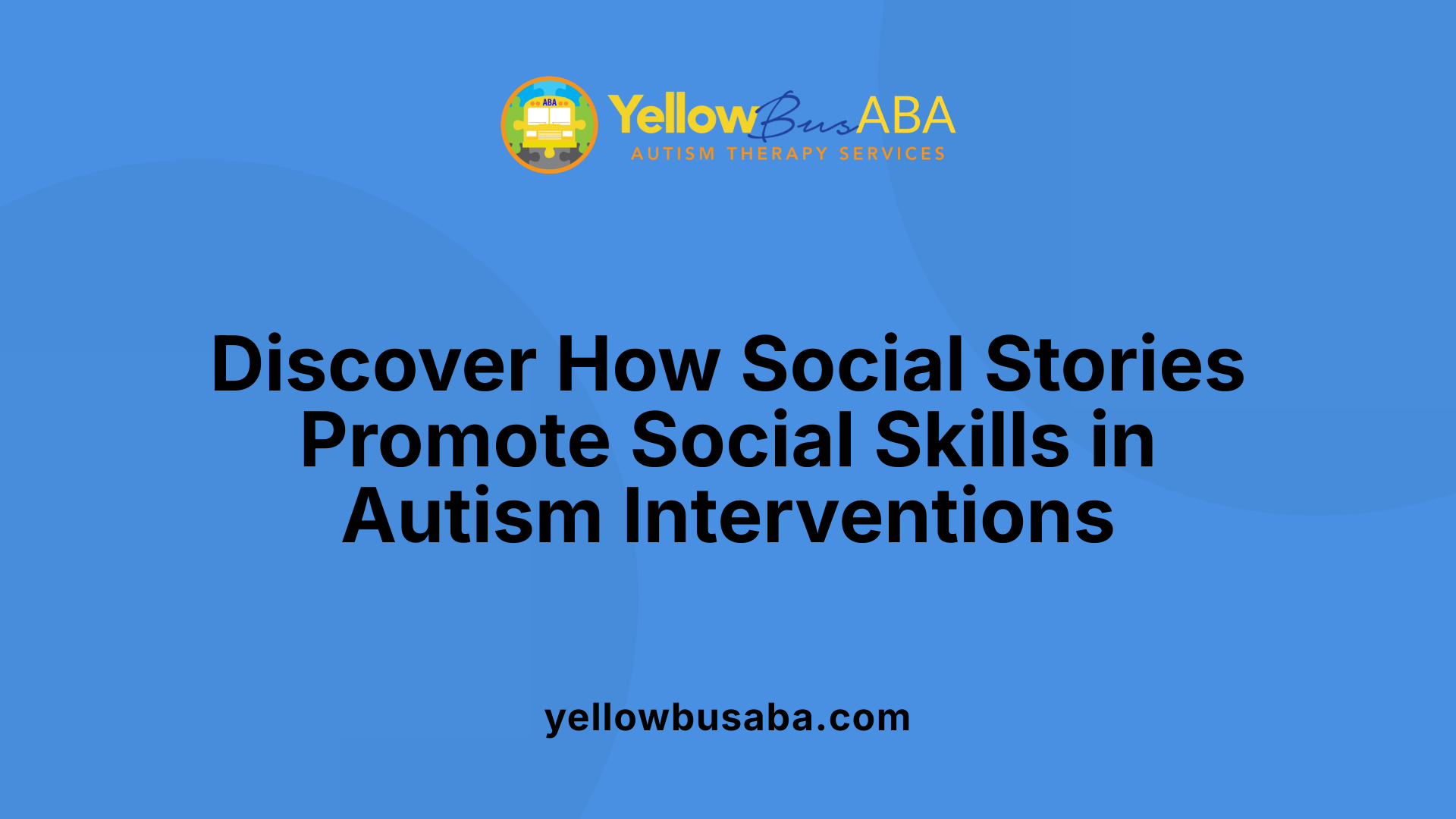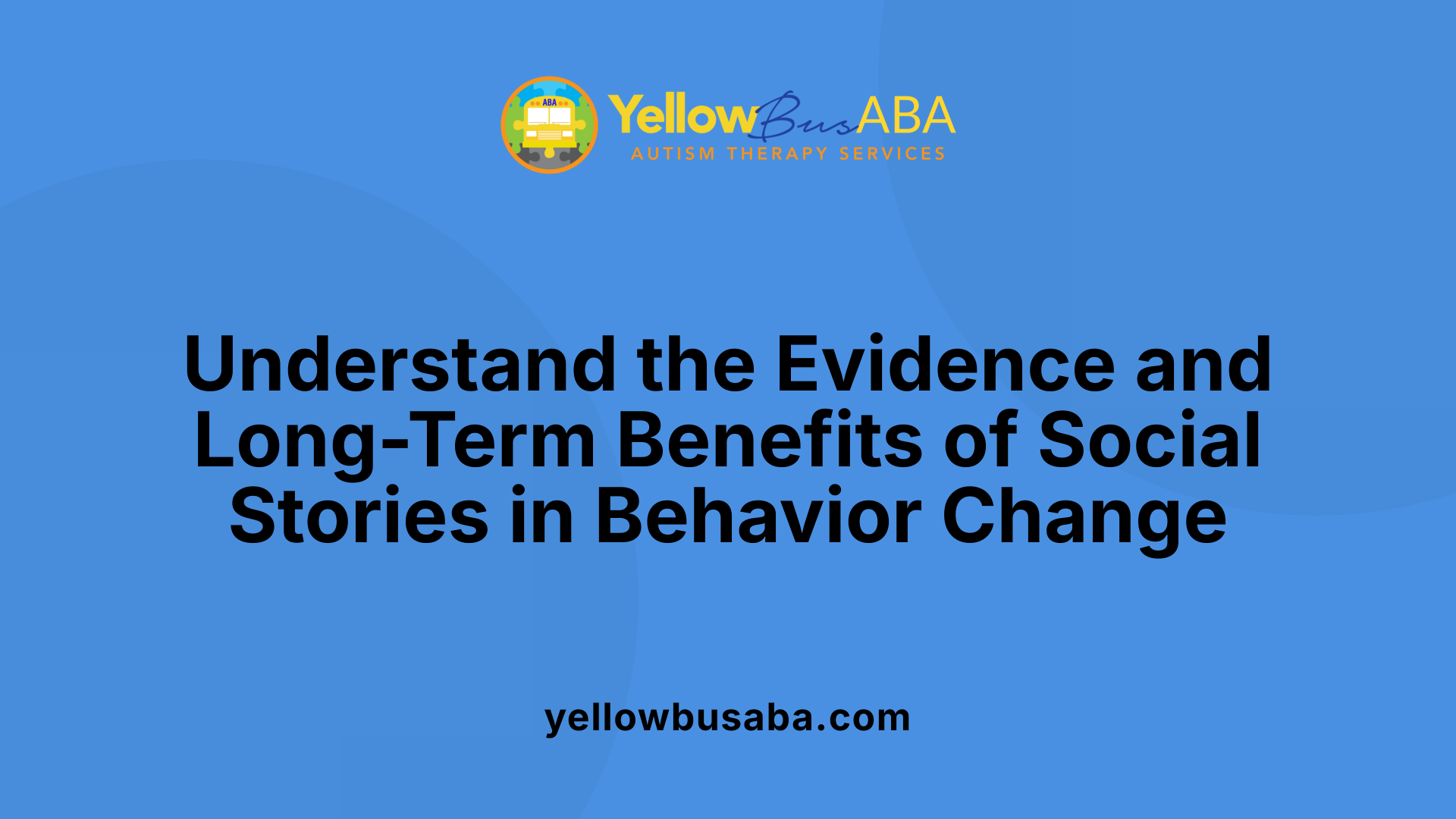Understanding Social Stories in ABA Therapy
Since their development in 1991 by Carol Gray, social stories have become a cornerstone in behavioral interventions for children with autism. These personalized narratives serve as effective tools within ABA therapy by illustrating social situations, expectations, and appropriate responses through simple, engaging formats. Their structured approach helps children interpret social cues, navigate new experiences, and develop essential social-emotional skills, significantly enhancing their overall ability to interact within various environments.
Origins and Development of Social Stories

What is the role of social stories in ABA therapy for children with autism?
Social stories serve an important purpose in ABA (Applied Behavior Analysis) therapy for children with autism. They are personalized narratives that describe specific social situations and the expected behaviors in an accessible, simple way. These stories are often supplemented with pictures, making social concepts clearer and easier to understand for children.
In practice, social stories help children interpret social cues, such as body language, facial expressions, and eye contact. They prepare children for upcoming social interactions or transitions, reducing anxiety and increasing their compliance. By modeling positive behaviors and clarifying what is expected, social stories support the development of social-emotional skills and self-regulation.
They are versatile tools that can be used proactively before challenging events or when a child struggles with particular skills. Within ABA therapy, social stories significantly enhance social understanding, helping children learn appropriate responses and improving their ability to navigate social situations effectively.
Overall, social stories are an engaging and individualized approach that reinforces social skills, leading to better behavioral outcomes and improved social competence.
What are the benefits of social stories in supporting social skills development?
Social stories are highly beneficial for developing social skills, especially in children with autism. They help children understand complex social cues and routines by illustrating real-life scenarios with photos, descriptions, and personalized content.
Using social stories promotes increased social understanding, empathy, and effective communication. They can reduce anxiety by providing predictability and clear guidance, which reassures children in unfamiliar or challenging settings.
In addition to understanding social norms, social stories facilitate the learning of conflict resolution, perspective-taking, and self-regulation skills. These stories can be tailored to specific situations such as sharing, turn-taking, making friends, or managing emotions.
Incorporating social stories into a broader intervention plan enhances social competence, supports emotional well-being, and encourages positive social interactions.
How are social stories used as a support tool in ABA therapy?
Within ABA therapy, social stories are employed as visual and written tools to support social learning. They are personalized narratives that incorporate clear, concrete language and often include pictures or photos to make social concepts more accessible.
These stories target specific social challenges, such as understanding personal space, transitioning between activities, or interpreting social norms. They are introduced through direct instruction, with therapists reading the stories aloud, using modeling, and prompting the child to engage.
Social stories prepare children for new or difficult social situations by depicting expected responses, which helps increase appropriate responses and social awareness. They are a practical, evidence-based method to foster social skills and behavioral development in a variety of settings.
How are social stories developed, structured, and customized for individual children?
Developing social stories begins with identifying the child's specific social needs and the particular situations that present challenges. The stories are then structured using simple, easily understandable language, and visual supports like pictures or multimedia are included to enhance comprehension.
Guidelines from Carol Gray focus on tailoring stories to the child's age, interests, and capabilities. Different sentence types—descriptive, perspective, directive, and affirmative—are used to craft the narrative.
The development process involves gathering comprehensive information about the child's experiences, understanding, and behaviors related to the targeted social skills. The story is then customized to reflect their perspective and include positive, supportive language.
Various tools, such as story templates and digital apps, help create personalized stories effectively, ensuring they are engaging and relevant to each child's needs.
What are practical techniques for using social stories effectively in therapy?
Successful implementation of social stories involves several practical techniques. First, stories should be individualized to address specific behaviors or situations relevant to the child's daily life.
Using visual aids like pictures and illustrations makes the stories more engaging and easier to grasp. Repeated reading or listening to the story—ideally a week or two before the event—helps the child internalize the social expectations.
It is important to write stories in positive language, use the first person when possible, and ensure a clear sequence of events.
Therapists can conduct interactive activities such as reading the story aloud, asking comprehension questions, and role-playing targeted behaviors. Reinforcing learned skills and re-reading stories regularly help solidify understanding and support generalization.
What impact do social stories have on behavior change and social understanding?
Social stories significantly influence behavior and social understanding. They help improve responses in social interactions, reduce problematic behaviors, and enhance awareness of social cues.
Most notably, social stories support children in developing self-regulation, understanding others' perspectives, and gaining confidence in social situations.
Consistent use in homes and classrooms fosters better peer interactions, interpretation of facial cues, and appropriate responses. While ongoing research continues to explore their full potential, evidence shows social stories are an effective component of intervention programs.
How can social stories be integrated with other teaching methods in ABA therapy?
Integrating social stories with other ABA techniques enhances their effectiveness. They can be combined with modeling, role-playing, and reinforcement strategies to promote the transfer of skills.
Using visual supports within stories alongside task analyses and prompting techniques helps solidify learning. Incorporating stories into broader behavior plans, alongside social skills training, enhances generalization and maintenance of behaviors.
This blended approach creates a comprehensive intervention that addresses multiple facets of social and behavioral development, maximizing therapeutic outcomes.
Structural Components and Customization of Social Stories

How are social stories developed, structured, and customized for individual children?
Social stories are carefully crafted tools that begin with a detailed assessment of the child's specific social needs and the particular situations or behaviors that require support. The development process involves gathering information about the child's understanding, experiences, and challenges to ensure the story is relevant and relatable.
The stories are structured using simple, straightforward language paired with visual aids like pictures, symbols, or multimedia elements to facilitate comprehension. Carol Gray's guidelines stress the importance of tailoring stories to the child's developmental level, interests, and unique needs.
Customization involves selecting appropriate characters, scenarios, and vocabulary that resonate with the child's life. The stories often follow a structured format, using different types of sentences such as descriptive, perspective, directive, and others, to create an effective teaching narrative.
Modern tools, including digital applications and templates, help caregivers and educators personalize stories efficiently. These tools enable the integration of multimedia and pictorial cues, making the stories more engaging and easier for children to understand.
What are the key elements that make a social story effective?
Effective social stories contain several vital components. Firstly, they share accurate and literal information that matches the child's level of understanding.
Understanding the child's perspective is crucial, allowing the story to be relatable and meaningful. A clear, structured format guides the child's grasp of social norms.
Positive language is emphasized to motivate and reinforce desirable behaviors, creating an encouraging atmosphere.
Inclusion of praise and reinforcement helps boost engagement and compliance. Relatable characters and realistic scenarios foster connection and interest.
Visual supports, such as pictures, videos, or multimedia tools, enhance comprehension and retention. The combination of these elements ensures that social stories are accessible, engaging, and impactful in teaching social skills.
What types of sentences are utilized in social stories, and how do they contribute to the story's effectiveness?
Social stories employ seven distinct types of sentences, each serving a specific purpose:
- Perspective sentences: Explain how others might feel or think, fostering empathy.
- Descriptive sentences: Set the scene by describing the social situation or environment.
- Directive sentences: Guide children on what to do in specific situations.
- Control sentences: Clarify expectations, boundaries, and rules.
- Affirmative sentences: Reinforce positive behaviors and choices.
- Cooperative sentences: Promote social interaction and sharing.
- Partial sentences: Provide essential information without overwhelming, often used to fill in gaps.
By mixing these sentence types, social stories create a comprehensive and positive narrative. This structure helps children interpret social cues, understand appropriate responses, and develop confidence in navigating social interactions.
How are social stories customized and adapted for different needs?
Customization is central to the effectiveness of social stories. They are tailored to address specific behaviors such as making friends, understanding personal space, managing transitions, or coping with emotions.
Stories can be adapted for various age groups and developmental levels, ensuring age-appropriate language and scenarios.
Caregivers and educators modify content to reflect real-life situations relevant to the child's environment—home, school, or community. This personalization helps children relate better and apply what they learn.
Digital tools and templates facilitate this process, allowing for quick adjustments based on ongoing observations or changing needs. The flexibility of social stories makes them a versatile tool for fostering social understanding, emotional regulation, and life skills.
| Aspect | Description | Examples |
|---|---|---|
| Development | Identifying needs, gathering info, structuring with visuals | Creating stories about sharing or transitions |
| Structure | Simple language, visual support, sentence types | Use of pictures, neutral characters, clear steps |
| Customization | Personalizing content, adapting sentences, scenario relevance | Making a story about a specific child's experience |
| Sentence Types | Perspective, descriptive, directive, etc. | Explaining feelings, setting rules, encouraging sharing |
| Application | Tailoring for age, need, environment | Stories for school, home, or therapy sessions |
This comprehensive approach ensures social stories are effective, relatable, and adaptable to each child's evolving needs.
Practical Approaches and Techniques for Implementation

Strategies for integrating social stories into daily routines
Incorporating social stories into everyday life helps children with autism apply learned social skills across different environments. One effective method is scheduling regular reading sessions, where stories are read daily or several times a week. Using stories to prepare for upcoming transitions or events—like starting school or visiting a new place—can reduce anxiety and build confidence.
Embedding social stories into natural routines, whether at home, in the classroom, or during therapy sessions, reinforces consistent behavior. Role-playing or modeling behaviors based on the stories enhances understanding and helps children practice appropriate responses. For instance, a story about sharing can be followed by activities that encourage turn-taking.
Visual supports such as pictures, storyboards, and multimedia tools make social stories more accessible. These visuals serve as cues that help children connect the narrative to real-life actions, facilitating better comprehension and retention.
The role of visual supports and multimedia
Visual supports play a pivotal role in making social stories engaging and understandable. Pictures, photographs, and digital images illustrate social situations, emotions, and expected behaviors, helping visual learners grasp concepts more easily.
Multimedia tools like videos, interactive apps, and digital storytelling platforms amplify the impact of social stories. For example, video modeling shows children actual social interactions, making behaviors more tangible.
Studies have shown that children respond well to multimedia social stories, as they increase engagement and help generalize learned skills across different settings. When combined with written narratives, these tools create multisensory experiences that reinforce understanding.
Techniques for reinforcing story content
Reinforcing social stories involves multiple steps to ensure children internalize and generalize the skills learned. One effective technique is re-reading stories frequently—ideally, a week or two before an event—to build familiarity and reduce anxiety.
Therapist-led activities, including reading aloud, asking comprehension questions, and role-playing, deepen understanding and encourage active participation. For example, after reading a story about polite phrases, the therapist or parent might model and prompt the child to practice these phrases.
Integrating social stories into daily routines—such as before lunch or during transitions—helps children see the relevance and apply lessons in real situations. Using positive language, praise, and encouragement reinforces motivation and confidence.
In summary, successful implementation combines individualized story content with visual and multimedia supports, consistent routine incorporation, and active reinforcement techniques. These strategies collectively enhance the child's social understanding and promote meaningful behavior change.
| Strategy | Description | Benefits |
|---|---|---|
| Routine embedding | Schedule story reading at consistent times | Builds predictability, reduces anxiety |
| Visual supports | Use pictures, storyboards, multimedia | Enhances understanding, visual learning |
| Active reinforcement | Role-play, questions, praise | Reinforces learning, improves retention |
| Repetition | Frequent re-reading | Promotes familiarization and confidence |
| Contextual application | Incorporate stories into daily activities | Facilitates generalization and independence |
Evaluating the Impact and Effectiveness of Social Stories

What impact do social stories have on behavior change and social understanding?
Social stories significantly influence behavior modification and social awareness, especially among children with developmental challenges such as autism spectrum disorder (ASD). These narratives provide explicit, tailored guidance that clarifies social cues and appropriate responses, making complex social norms easier to understand.
As a result, children often demonstrate improved social behaviors, like better eye contact, understanding body language, and engaging in reciprocal interactions. They also help reduce problematic behaviors such as tantrums, hitting, or crying by offering positive alternatives and responses.
In addition, social stories promote self-regulation and increase confidence in social settings. They foster empathy by modeling typical social reactions, which aids children in interpreting others' emotions and intentions.
When integrated into daily routines at home or in school, social stories enhance peer interactions, support emotional regulation, and help children respond more appropriately to social cues. While consistent use leads to these benefits, it’s important to note that ongoing research continues to explore their full potential. Nevertheless, they remain a valuable part of comprehensive behavioral and social skills programs.
What does research say about the effectiveness of social stories?
Numerous studies affirm the positive effects of social stories on children with autism. For example, a pivotal 2015 study with 30 participants showed that children who received social story interventions exhibited noticeable improvements in social interaction skills. About half of them demonstrated significant progress in engaging with peers, understanding social cues, and adapting their behavior.
Research also highlights innovations like multimedia social stories—videos, apps, and digital content—that boost engagement and facilitate skill generalization across settings. Video modeling, in particular, has proven effective when paired with social stories, enhancing eye contact, initiating conversation, and smiling.
Furthermore, musically adapted social stories have shown immediate benefits, especially in reducing problematic behaviors such as aggression or avoidance. These stories, combined with music or rhythm, can be more engaging and effective than traditional text-based narratives.
Overall, scientific evidence underscores that social stories improve social communication, decrease undesirable behaviors, and support emotional self-regulation, making them essential tools in autism interventions.
How are social stories applied in real-world environments, and what are their long-term benefits?
In everyday settings like homes and classrooms, social stories are highly adaptable tools that prepare children for social situations and transitions. Teachers and parents incorporate them into routines to introduce new experiences, explain social expectations, and manage changes, reducing anxiety and resistance.
With consistent application, children internalize social norms, which leads to better peer relationships and increased independence. For example, social stories about sharing or turn-taking help children practice these skills in real situations.
In therapeutic contexts, such as Applied Behavior Analysis (ABA), social stories assist in teaching specific social behaviors and emotional responses. They are often personalized to target individual needs, making them highly effective.
The long-term advantages include improved social competence, stronger friendships, enhanced emotional regulation, and increased self-esteem. As children grow, social stories can be adapted further to support more complex social situations, helping them develop into confident and socially skilled individuals.
This versatility ensures that social stories not only provide immediate behavioral support but also promote sustained social development over time.
| Application Setting | Purpose | Long-term Outcome | Customized Features |
|---|---|---|---|
| Home | Routine and skill development | Increased independence and emotional regulation | Personalization for daily routines |
| School | Classroom behavior and social skills | Better peer interactions and social understanding | Adapted to classroom norm scenarios |
| Therapy Centers | Social skill teaching | Improved social competence and self-confidence | Tailored to individual therapy goals |
| Community Outings | Transition management | Reduced anxiety and enhanced social participation | Context-specific social narratives |
Empowering Social Development Through Stories
In summary, social stories serve as a fundamental component of ABA therapy for children with autism by providing highly personalized, structured narratives that promote understanding, predictability, and positive behavior. Their development, structure, and customization allow them to effectively address individual social challenges, while their integration with other teaching techniques enhances learning outcomes. Supported by research, social stories have demonstrated significant benefits in improving social skills, reducing problematic behaviors, and fostering social independence. When used consistently across settings, they empower children to navigate social worlds with confidence and competence, making them invaluable tools for clinicians, educators, and families committed to nurturing social growth in children with autism.
References
- Social Stories: A Tool for Autism Support
- What Are Social Stories for Kids With Autism?
- What Are Social Stories for Autism? - SkyCare ABA
- [PDF] The Effectiveness of Social Stories among Children and ... - ERIC
- Social Stories for Autistic Children – The Ultimate Guide
- Free library of Social Stories for Autism | Autism Behavior Services, Inc.
- Social Narratives in Context of Applied Behavior Analysis?
- Using Social Stories to Improve Your Child's Understanding ...
- Using Social Stories to Improve Your Child's Understanding ...






